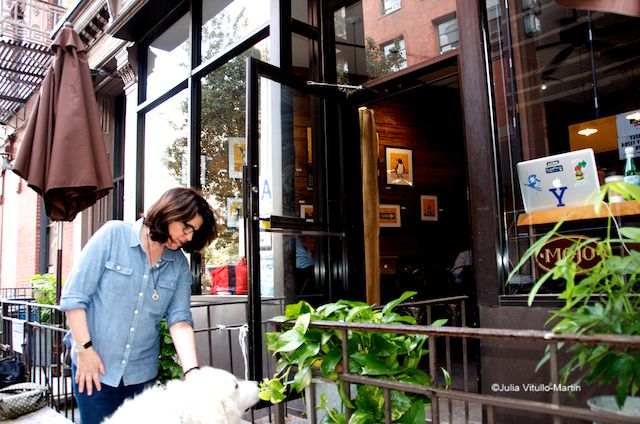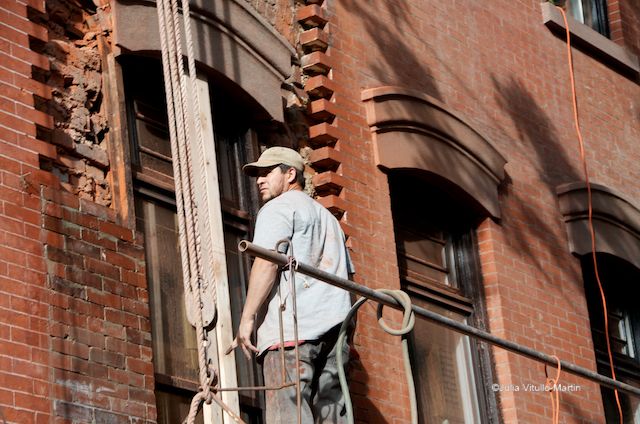Last-Minute NYC Holiday Gift Guide 🎁
We’ve created a holiday gift guide with presents for the intrepid New Yorker that should arrive just in time—


With all its mad energy and contradictions, New York makes a wonderful literary character. And few novelists use the city more effectively than Cathleen Schine, whose established territory is New York City and its cultural suburbs. She has her own quirky view of the terrain. Her novel, The New Yorkers, for example, centered on our indispensable local citizenry—dogs. Called “a redemptive fairy tale of urban loneliness” by Liesl Schillinger in the New York Times, it was really about the transformative power of unconditional love—a Schine theme.
While The New Yorkers was located on a “slightly raffish” and “not terribly clean” street in the West 70s, her latest novel, Fin & Lady, is set on Charles Street in Greenwich Village—one of the loveliest streets in that celebrated neighborhood. One serene October day, we met Schine in the Village to take a look at Charles Street itself—“such a promising street, so small and unlikely and bohemian”—and to talk about Fin & Lady.
We started at Mojo Coffee, at 128 Charles, where we were encircled by Schine-like characters—including a spectacular Great Pyrenees Schine admired—and talked about the novel.

When it opens in 1964, 11-year-old charming Fin and his glamorous half-sister, 23-year-old Lady, who drives a turquoise Karmann Ghia convertible, have just been orphaned. We soon learn that we are about to enter that rarified literary world of a New York City bereft of responsible grownups—virtually every child’s dream until it actually happens.
The dream plays out in the Village (“where Bob Dylan lived,” thinks Fin). Theirs was one of the “high, slender houses,” with a “thick, beautiful wisteria” growing up from the patch of dirt that was the front yard. Fin looks up at the night sky: “No stars in New York City. Just him and Lady.” They ate ice cream at Schrafft’s, went to Fiddler on the Roof, counted the stars in Grand Central, admired the Kodak Colorama, and ate Chicken Kiev at the Russian Tea Room—a legendary but disappearing New York (though thanks to the Grand Central Partnership, we do have the gorgeously restored stars over the main concourse).
In her beauty, narcissism, and irresponsibility Lady is reminiscent of Jessa in Girls. “Yes, like Jessa she’s careless of other people,” says Schine. “She’s selfish, but she’s also incredibly generous.” Lady has an active but unhappy love life (before he died, her father had called her “that little tart”), and three suitors who pursue her.
Lady’s carelessness probably mattered less in the early 1960s, when children could roam fairly freely. New York’s “rogue crime wave,” to use historian Erik Monkkonen’s term, which had begun in 1958, had not yet reached terrifying proportions. Much of the Village was still inhabited by Italian working-class families, and streets were watched carefully, as Jane Jacobs so famously noted in The Death and Life of Great American Cities.
We headed up Charles Street in search of a townhouse like the one featured on Fin & Lady‘s cover. In real life the cover building’s address is 52 West 11th Street. Its long-time owner, the late Anne Bancroft (or Mrs. Robinson, to all of a certain age), is seen in the photo lounging with great insouciance on her stoop.
The street shows all the signs of attentive care from devoted residents–flower beds, gardens, absence of litter, and lavish renovations of historic buildings. The house of the poet Hart Crane, for example, is being restored virtually by hand, brick by brick.

A neighbor pointed out Sarah Jessica Parker’s house, every bit as fine-looking and exuberant as one would expect from the Sex and the City star.
To find a sufficiently outré neighborhood today, Lady would have to abandon Charles Street for Greenpoint–just as she rejected the Park Avenue of her parents for the Village of Bob Dylan.
Julia Vitullo-Martin is a Senior Fellow at the Regional Plan Association and director of its Center for Urban Innovation. Get in touch with her @JuliaManhattan.
Subscribe to our newsletter